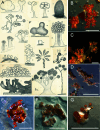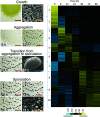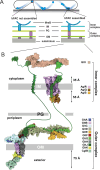Milestones in the development of Myxococcus xanthus as a model multicellular bacterium
- PMID: 40525847
- PMCID: PMC12288465
- DOI: 10.1128/jb.00071-25
Milestones in the development of Myxococcus xanthus as a model multicellular bacterium
Abstract
From the humblest of beginnings (i.e. a pile of dry cow dung) over 80 years ago, the Gram-negative bacterium Myxococcus xanthus has emerged as a premier model system for studying diverse fields of bacteriology, including multicellular development, sporulation, motility, cell-envelope biogenesis, spatiotemporal regulation, signaling, photoreception, kin recognition, social evolution, and predation. As the flagship representative of myxobacteria found in varied terrestrial and aquatic environments, M. xanthus research has evolved into a collaborative global effort, as reflected by the contributions to this article. In celebration of the upcoming 50th anniversary of the International Conference on the Biology of Myxobacteria, this review highlights the historical and ongoing contributions of M. xanthus as a multifaceted model bacterium.
Keywords: cell division; cell polarity; evolution; gliding motility; kin recognition; microbial ecology; multicellularity; myxobacteria; peptidoglycan; photoreception; polysaccharides; predation; secondary metabolites; signal transduction; sporulation; type 4 pilus.
Conflict of interest statement
The authors declare no conflict of interest.
Figures









Similar articles
-
Unorthodox regulation of the MglA Ras-like GTPase controlling polarity in Myxococcus xanthus.FEBS Lett. 2023 Mar;597(6):850-864. doi: 10.1002/1873-3468.14565. Epub 2023 Jan 4. FEBS Lett. 2023. PMID: 36520515 Review.
-
The Hsp70-like StkA functions between T4P and Dif signaling proteins as a negative regulator of exopolysaccharide in Myxococcus xanthus.PeerJ. 2015 Feb 3;3:e747. doi: 10.7717/peerj.747. eCollection 2015. PeerJ. 2015. PMID: 25674362 Free PMC article.
-
Gliding motility in bacteria: insights from studies of Myxococcus xanthus.Microbiol Mol Biol Rev. 1999 Sep;63(3):621-41. doi: 10.1128/MMBR.63.3.621-641.1999. Microbiol Mol Biol Rev. 1999. PMID: 10477310 Free PMC article. Review.
-
Predation, evo-devo, and historical contingency: A nematode predator drives evolution of aggregative multicellularity.bioRxiv [Preprint]. 2025 May 7:2025.05.04.652091. doi: 10.1101/2025.05.04.652091. bioRxiv. 2025. PMID: 40654956 Free PMC article. Preprint.
-
Genomic insights into novel predatory myxobacteria isolated from human feces.Microbiol Spectr. 2025 Jul;13(7):e0214724. doi: 10.1128/spectrum.02147-24. Epub 2025 May 22. Microbiol Spectr. 2025. PMID: 40401933 Free PMC article.
Cited by
-
Tissue-like structures formed by a bacterium.bioRxiv [Preprint]. 2025 Jun 28:2025.06.27.661998. doi: 10.1101/2025.06.27.661998. bioRxiv. 2025. PMID: 40666919 Free PMC article. Preprint.
References
-
- Waite DW, Chuvochina M, Pelikan C, Parks DH, Yilmaz P, Wagner M, Loy A, Naganuma T, Nakai R, Whitman WB, Hahn MW, Kuever J, Hugenholtz P. 2020. Proposal to reclassify the proteobacterial classes Deltaproteobacteria and Oligoflexia, and the phylum Thermodesulfobacteria into four phyla reflecting major functional capabilities. Int J Syst Evol Microbiol 70:5972–6016. doi: 10.1099/ijsem.0.004213 - DOI - PubMed
-
- Thaxter R. 1892. On the myxobacteriaceæ, a new order of schizomycetes. Bot Gaz 17:389–406. doi: 10.1086/326866 - DOI
Publication types
MeSH terms
LinkOut - more resources
Full Text Sources
Research Materials

